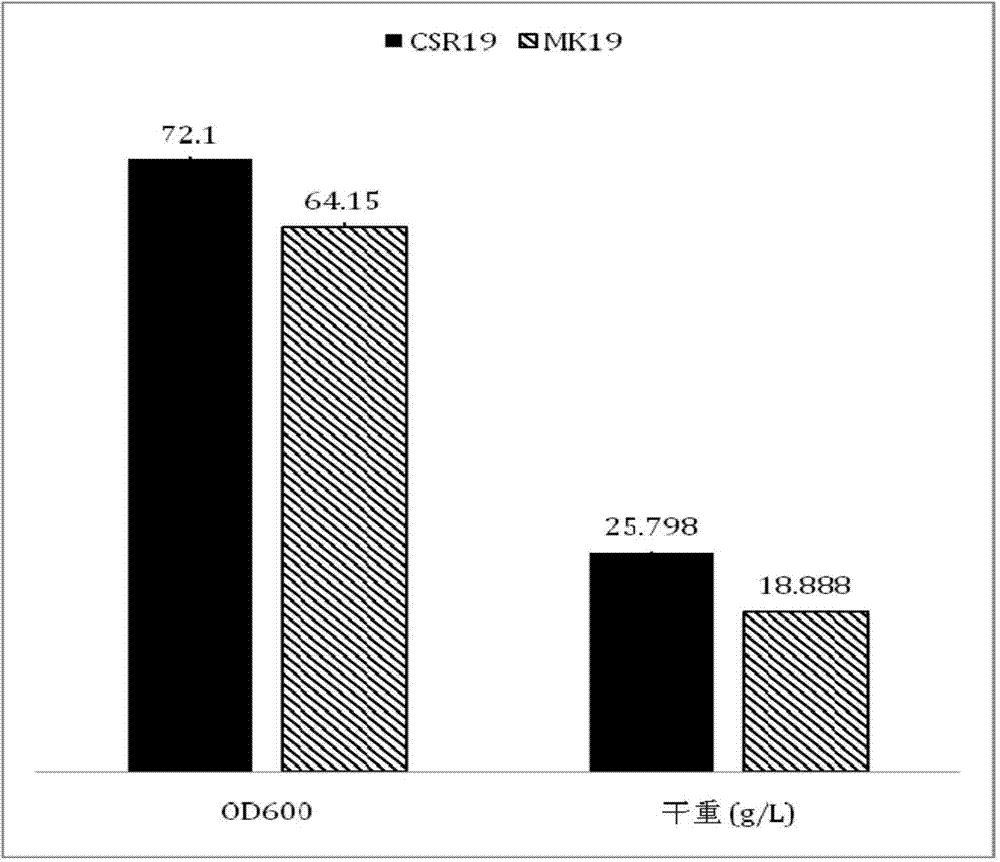Phaffia rhodozyma strain obtained by efficiently over-expressing endogenous astaxanthin synthetase gene
A technology of astaxanthin synthase and Phaffia yeast, which is applied in the biological field, can solve the problems of high price and increased demand for natural astaxanthin, and achieve high conversion efficiency
- Summary
- Abstract
- Description
- Claims
- Application Information
AI Technical Summary
Problems solved by technology
Method used
Image
Examples
Embodiment 1
[0087] Example 1 Preparation of Phaffia cDNA
[0088] 1.1 Extraction of Phaffia total RNA
[0089] (1) Take an appropriate amount of Phaffia rhodozyma MK19 cells cultured to mid-logarithmic phase [disclosed in Chinese patent CN101717731A], grind with liquid nitrogen, add 1ml Trizol reagent (Invitrogen), shake vigorously for 5 minutes, and incubate at room temperature for 5 minutes ;
[0090] (2) Add 0.2ml chloroform, shake vigorously for 15-30 seconds, and incubate at room temperature for 3 minutes;
[0091] (3) 4°C, 12000rpm centrifuge for 15 minutes, the sample will be divided into three layers, transfer the colorless water phase of the upper layer to a new tube, and then proceed to the next step;
[0092] (4) Add one volume of isopropanol, mix by inverting, leave at room temperature for 10 minutes, centrifuge at 12000rpm at 4°C for 10 minutes, and discard the supernatant;
[0093] (5) Add 1ml of 75% ethanol to wash the precipitate, centrifuge at 7500rpm for 5 minutes at ...
Embodiment 2
[0108] Example 2 Acquisition of the Phaffia astaxanthin synthase gene crtS containing ribosome binding site and construction of the gene expression plasmid
[0109] 2.1 Primer design
[0110] According to the sequence of the crtS gene in GenBank (GenBank accession number is DQ002006), the synthetic cloning primers were designed as follows:
[0111] CRTSCPF: 5'—AATG CCATGG CCACCTACTTTCTCCATATG—3'
[0112] CRTSCPR: 5'-AA CTGCAG GACGACGTAGAAGTCATAGC—3'
[0113] NcoI and PstI restriction sites were designed at both ends of the cloning primer (see the italicized and underlined part in the above sequence)
[0114] 2.2 PCR amplification of the Phaffia astaxanthin synthase gene crtS containing ribosome binding site
[0115] CRTSCPF and CRTSCPR were used as primers, and the Phaffia cDNA obtained above was used as a template to amplify the cDNA fragment of crtS. The PCR reaction system was as follows:
[0116]
[0117] The reaction conditions are: 94°C for 3 minutes; 30 cycle...
Embodiment 3
[0124] Example 3 Overexpression of astaxanthin synthase in Phaffia MK19 promotes the increase of astaxanthin production
[0125] 3.1 Preparation of Phaffia MK19 electroporation competent cells and their electroporation transformation
[0126] 1) Inoculate the Phaffia seeds cultivated overnight in YPD medium into 100ml YPD medium at an inoculum size of 0.5%, cultivate to OD at 21°C and 200rpm 600 value is 1;
[0127] 2) Collect the cells by centrifugation at 8000 rpm at 4°C for 8 minutes, resuspend the cells with 13ml of 50mM potassium phosphate buffer (containing 25mM dithiothreitol) with a pH value of 7.0, and incubate at 21°C for 15 minutes;
[0128] 3) The cells were washed twice with 13ml of STM buffer, and finally resuspended in 0.8ml of STM buffer;
[0129] (STM buffer: 270mM sucrose, 10mM Tris HCl, pH7.5, 1mM MgCl 2 )
[0130] 4) Mix 4 μl (5 μg / ul) of plasmid DNA with 80 μl of the above-mentioned resuspended cells, place on ice for 15 minutes, and then transfer to a...
PUM
 Login to View More
Login to View More Abstract
Description
Claims
Application Information
 Login to View More
Login to View More - Generate Ideas
- Intellectual Property
- Life Sciences
- Materials
- Tech Scout
- Unparalleled Data Quality
- Higher Quality Content
- 60% Fewer Hallucinations
Browse by: Latest US Patents, China's latest patents, Technical Efficacy Thesaurus, Application Domain, Technology Topic, Popular Technical Reports.
© 2025 PatSnap. All rights reserved.Legal|Privacy policy|Modern Slavery Act Transparency Statement|Sitemap|About US| Contact US: help@patsnap.com



